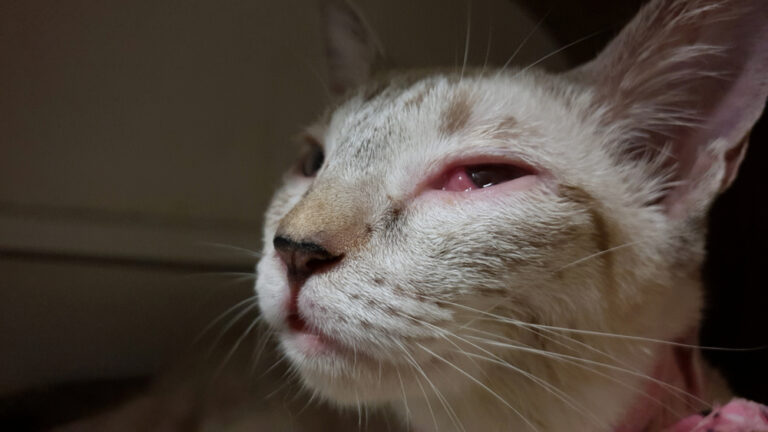
Red eye is one of the most common ophthalmic presentations in veterinary medicine and can be caused by a wide range of problems, from a minor irritation to something more serious. Read our Urgent Pet Care Omaha team’s guide to learn what may be behind your four-legged friend’s red eye.
Pet red eye types
Numerous eye structures can be affected and cause your pet’s eye to appear red, such as:
- Sclera — The sclera is the white part of the eye, and redness occurs when the sclera’s blood vessels are enlarged.
- Conjunctiva — The conjunctiva is a thin membrane that lines the eyelids and covers the sclera. Conjunctival redness occurs when the tissue is inflamed and the blood vessels enlarge.
- Subconjunctiva — Subconjunctival hemorrhage occurs when tiny blood vessels underneath the conjunctiva break and the white part of the eye fills with blood.
- Cornea — An injured cornea responds by forming new blood vessels on the corneal surface, which can cause the eye to appear red.
- Anterior chamber — Blood that pools in the eye’s anterior chamber can completely or partially fill the space, causing complete redness or a red line in the eye.
Pet red eye causes
Anything that irritates your pet’s eye can lead to redness, but a more serious condition can also cause red eye. The following are common red eye causes in pets:
- Conjunctivitis — This is inflammation of the conjunctiva and one of the most common red eye causes in pets. Conditions that can result in conjunctivitis include:
- Viral infections — Viral infections, such as feline herpesvirus, are the most common cause of conjunctivitis in cats.
- Bacterial infections — Bacterial infections, such as chlamydiosis, can inflame the conjunctiva, leading to redness.
- Foreign bodies — Foreign bodies, such as dust, grass awns, or other debris, can irritate the conjunctiva and cause inflammation and redness.
- Chemical irritants — Exposure to chemicals, smoke, or other pollutants can result in conjunctivitis.
- Corneal ulcer — An abrasion or wound on the eye surface can be caused by a scratch, foreign body, chronic irritation, inadequate lubrication, exposure to a chemical, or infection. The lesion can affect only the most superficial corneal layer or penetrate to the deepest layer (i.e., Descemet’s membrane). Corneal ulcers tend to be extremely painful for pets. Other signs may include eye swelling, holding the eye tightly closed, and clear or mucoid eye discharge.
- Keratoconjunctivitis sicca (KCS) — KCS is also known as dry eye and occurs when the eye is inadequately lubricated, which leads to inflammation of the cornea and surrounding tissues. The most common cause is immune-mediated damage to the tear-producing glands. Other signs include excessive blinking and a thick, yellowish ocular discharge.
- Uveitis — Uveitis is inflammation of internal eye structures, including the ciliary body, iris, and choroid. Potential causes include infection, metabolic disease, high blood pressure, immune-mediated disease, trauma, lens luxation, and eye tumors. Other signs include squinting, tearing, and eye cloudiness.
- Glaucoma — This increased ocular pressure can be caused by an anatomical drainage angle abnormality, uveitis, lens luxation, intraocular bleeding, or a tumor. Other signs include clean ocular discharge, eye bulging, eye rubbing, and sudden blindness.
Pet red eye diagnosis
Since numerous conditions can cause your pet’s eye redness, your veterinarian must perform a thorough diagnostic work-up to determine the reason. Potential diagnostics include:
- History — Knowing when the problem started and its progression is critical to understanding what is affecting your pet. In addition, you should provide information about your pet’s known health conditions and their medications.
- Physical examination — Eye redness can be caused by systemic issues, and a nose-to-tail examination checking for any abnormalities is important.
- Ophthalmic examination — Your veterinarian will use an ophthalmoscope to carefully assess your pet’s eyes.
- Fluorescein stain — A fluorescein stain is helpful to highlight corneal abrasions and ulcers.
- Schirmer tear test — A special paper is placed under your pet’s lower eyelid to measure tear production.
- Tonometer — Your veterinarian may use a tonometer to measure your pet’s eye pressure.
- Blood work — In some cases, blood work may be necessary to assess your pet’s overall health.
- Blood pressure measurement — Your veterinarian may recommend a blood pressure assessment.
Pet red eye treatment
Your pet’s treatment will depend on the cause of their eye redness. Eye drops are often needed several times a day to manage or prevent infection and keep your pet’s eye comfortable. Systemic medication may also be necessary to manage pain. In some cases, surgery may be recommended.
Since eye redness can indicate a significant problem that may endanger your pet’s vision, you should always seek veterinary care if your pet has a red eye. Contact our Urgent Pet Care Omaha if your four-legged friend’s eyes need attention.

